
RIVASTIGMINE ABABOR 2 mg/ml ORAL SOLUTION

How to use RIVASTIGMINE ABABOR 2 mg/ml ORAL SOLUTION
Introduction
Prospect: Information for the User
Rivastigmine Ababor 2 mg/ml Oral Solution EFG
Read the entire prospectus carefully before starting to take this medication, as it contains important information for you
- Keep this prospectus, as you may need to read it again.
- If you have any doubts, consult your doctor, pharmacist, or nurse.
- This medication has been prescribed to you only, and you should not give it to others, even if they have the same symptoms as you, as it may harm them.
- If you experience adverse effects, consult your doctor, pharmacist, or nurse, even if they are not listed in this prospectus. See section 4.
Contents of the Prospectus
- What is Rivastigmine Ababor and what is it used for
2 What you need to know before taking Rivastigmine Ababor
- How to take Rivastigmine Ababor
- Possible adverse effects
- Storage of Rivastigmine Ababor
- Content and additional information
1. What is Rivastigmine Ababor and what is it used for
The active ingredient is Rivastigmine.
Rivastigmine belongs to the group of substances called cholinesterase inhibitors.
In patients with Alzheimer's dementia or dementia due to Parkinson's disease, certain nerve cells die in the brain, resulting in low levels of the neurotransmitter acetylcholine (a substance that allows nerve cells to communicate with each other). Rivastigmine acts by blocking the enzymes that break down acetylcholine: acetylcholinesterase and butyrylcholinesterase. By blocking these enzymes, rivastigmine allows acetylcholine levels to increase in the brain, helping to reduce the symptoms of Alzheimer's disease and dementia associated with Parkinson's disease.
Rivastigmine Ababor is used for the treatment of adult patients with mild to moderately severe Alzheimer's dementia, a progressive brain disorder that gradually affects memory, intellectual ability, and behavior. It can also be used for the treatment of dementia in adult patients with Parkinson's disease.
2. What you need to know before taking Rivastigmine Ababor
Do not take Rivastigmine Ababor
- if you are allergic to rivastigmine or any of the other components of
this medication (including those listed in section 6).
If this happens, tell your doctor and stop taking Rivastigmine Ababor
Warnings and precautions
Consult your doctor before starting to take Rivastigmine Ababor.
- if you have or have ever had an irregular or slow heart rhythm
- if you have or have ever had an active stomach ulcer
- if you have or have ever had difficulty urinating
- if you have or have ever had epileptic seizures (attacks or convulsions)
- if you have or have ever had severe respiratory disease or asthma
- if you have or have ever had kidney function disorders
- if you have or have ever had liver function disorders
- if you suffer from tremors
- if you have low body weight
- if you experience gastrointestinal reactions such as nausea, vomiting, and diarrhea. You may become dehydrated (lose a lot of fluid) if vomiting or diarrhea is prolonged
If you are in any of these situations, your doctor may consider it necessary to monitor you more closely while you are being treated.
If you forgot to take Rivastigmine Ababor for more than three days, do not take the next dose until you have consulted your doctor.
Children and adolescents
There is no relevant use of Rivastigmine Ababor in the pediatric population for the treatment of Alzheimer's disease.
Use of Rivastigmine Ababor with other medications
Tell your doctor or pharmacist if you are using, have recently used, or may need to use any other medication.
Rivastigmine should not be administered at the same time as other medications with similar effects. Rivastigmine may interfere with anticholinergic medications (medications used to relieve stomach cramps or spasms, to treat Parkinson's disease, or to prevent
travel sickness).
Rivastigmine Ababor should not be administered at the same time as metoclopramide (a medication used to relieve or prevent nausea and vomiting). Taking the two medications together could cause problems such as stiff limbs and trembling hands.
In case you need to undergo surgery while taking rivastigmine, inform your doctor before you are given any anesthetic, as rivastigmine may exaggerate the effects of some muscle relaxants during anesthesia.
Care should be taken when taking rivastigmine with beta-blockers (medications such as atenolol used for hypertension, angina, and other heart conditions). Taking the two medications together could cause problems such as a decrease in heart rate (bradycardia) leading to fainting or loss of consciousness.
Pregnancy, breastfeeding, and fertility
If you are pregnant or breastfeeding, or think you may be pregnant or plan to become pregnant, consult your doctor before using this medication.
If you are pregnant, it is necessary to evaluate the benefits of using Rivastigmina Ababor against the possible adverse effects for the fetus.
It is preferable to avoid the use of Rivastigmina Ababor during pregnancy, unless it is clearly necessary. Inform your doctor if you become pregnant during treatment.
Women being treated with Rivastigmina Ababor should not breastfeed their children.
Driving and using machines
Your illness may affect your ability to drive or use machinery, and you should not carry out these activities unless your doctor indicates that it is safe to do so.
Rivastigmine Ababor may cause dizziness and drowsiness, mainly at the start of treatment or when increasing the dose. If you experience these effects, you should not drive, use machinery, or perform tasks that require your attention.
Important information about some of the components of Rivastigmine Ababor 2 mg/ml Oral Solution
One of the excipients in Rivastigmine Ababor oral solution is sodium benzoate. This medication may be irritating to the skin, eyes, and mucous membranes because it contains benzoic acid.
Rivastigmine Ababor also contains 1.867 mg of sodium per ml of solution, which should be taken into account in the treatment of patients with low-sodium diets.
3. How to take Rivastigmine Ababor
Follow your doctor's instructions for taking this medication exactly. If you are in doubt, consult your doctor again.
How to start treatment
Your doctor will tell you what dose of Rivastigmine to take
? Treatment usually starts with a low dose
? Your doctor will gradually increase the dose depending on how you respond to treatment
? The maximum dose that should be taken is 6 mg twice a day
Your doctor should evaluate periodically whether it has the desired effects. Your doctor will also monitor your weight while you are taking this medication
If you have not taken Rivastigmine for more than three days, do not take the next dose until you have spoken with your doctor.
Taking this medication
? Inform your caregiver that you are taking Rivastigmine Ababor.
? For your medication to have the desired effect, you must take it every day
? Rivastigmine Ababor should be taken twice a day with meals (in the morning and at night)
How to take this medication
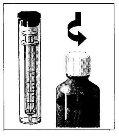
- Prepare the bottle and syringe:
? Remove the syringe from its protective case
? Press and turn the child safety lock to open the bottle.
- Insert the syringe adapter into the bottle cap
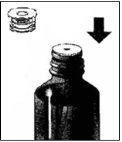
3. Insert the syringe into the adapter
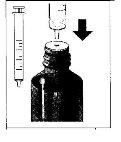 ?
?
? Insert the syringe needle into the bottle cap.
- Fill the syringe
? Pull the syringe plunger until the liquid reaches the mark of the dose that your doctor has prescribed
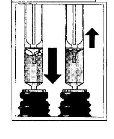
- Eliminate bubbles
? Eliminate large bubbles with alternating movements of the plunger.
? A couple of small bubbles are not important and do not affect the dose in any way.
? Check that the dose is correct
? Then remove the syringe from the bottle.
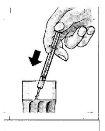
- Take your medicine
? Take the dose directly from the syringe.
? You can also mix it with water in a small glass. Stir and drink the mixture completely.
- After using the syringe
? Clean the outside of the syringe and adapter with a clean cloth.
? Then return the syringe to its protective case.
? Put the child safety lock on the bottle to close it.
If you take more Rivastigmine Ababor than you should
In case of overdose or accidental ingestion, consult your doctor, pharmacist, or call the Toxicology Information Service, phone 91 562 04 20, indicating the medication and the amount taken.
Some people who have accidentally taken higher doses have suffered nausea, vomiting, diarrhea, high blood pressure, and hallucinations. It can also cause a slowing of the heart rate and fainting.
If you forget to take Rivastigmine Ababor
If you forget your dose of rivastigmina Ababor, wait and take the next dose at the usual time. Do not take a double dose to make up for the missed doses.
If you have any other questions about the use of this medication, ask your doctor or pharmacist.
4. Possible adverse effects
Like all medications, this medication can cause adverse effects, although not all people experience them.
The tendency to notice adverse effects is more frequent when starting to take your medication or when increasing the dose. Adverse effects will disappear gradually as your body gets used to the medication.
Very common:(may affect more than 1 in 10 people)
- Dizziness
- Loss of appetite
- Stomach problems such as nausea, vomiting, diarrhea
Common:(may affect up to 1 in 10 people)
- Anxiety
- Sweating
- Headache
- Burning
- Weight loss
- Stomach pain
- Agitation
- Feeling of fatigue or weakness
- General malaise
- Tremor or feeling of confusion
- Decreased appetite
- Nightmares
Uncommon:(may affect up to 1 in 100 people)
- Depression
- Difficulty sleeping
- Fainting or accidental falls
- Changes in liver function
Rare:(may affect up to 1 in 1,000 people)
- Chest pain
- Skin rash
- Epileptic seizures (attacks or convulsions)
- Stomach and intestinal ulcers
Very rare:(may affect up to 1 in 10,000 people)
- High blood pressure
- Urinary tract infection
- Hallucinations
- Heart rhythm problems (fast or slow heart rate)
- Gastrointestinal bleeding (blood in stool or vomit)
- Pancreatitis (severe pain in the upper abdomen, often accompanied by nausea and vomiting)
Frequency not known:(cannot be estimated from available data)
- Severe vomiting that can cause esophageal rupture (part of the digestive tube that connects the mouth to the stomach)
Frequency not known:(cannot be estimated from available data)
- Dehydration (excessive fluid loss)
- Liver problems (yellow skin, yellowing of the whites of the eyes, abnormal darkening of urine or nausea, vomiting, fatigue, and loss of appetite)
Frequency not known:(cannot be estimated from available data)
- Aggression, feeling of restlessness
- Irregular heartbeat
- Pisa syndrome (a condition that involves involuntary muscle contraction and abnormal tilting of the body and head to one side)
Patient with dementia associated with Parkinson's disease
These patients experience some adverse effects more frequently, as well as additional adverse effects:
Very common:(may affect more than 1 in 10 people)
- Tremor
- Fainting
- Accidental falls
Common:(may affect up to 1 in 10 people)
- Anxiety
- Restlessness
- Fast and slow heart rate
- Difficulty sleeping
- Excessive saliva and dehydration
- Abnormally slow or uncontrolled movements
- Worsening of Parkinson's disease or development of similar symptoms (muscle stiffness, difficulty moving, and muscle weakness)
Uncommon:(may affect up to 1 in 100 people)
- Irregular heartbeat and loss of movement control
Frequency not known:(cannot be estimated from available data)
- Pisa syndrome (a condition that involves involuntary muscle contraction and abnormal tilting of the body and head to one side)
The following adverse reactions have been observed with the use of Rivastigmine transdermal patches, which may occur with the oral solution:
Common:
- Fever
- Severe confusion
- Urinary incontinence (inability to retain urine properly)
Uncommon:(may affect up to 1 in 100 people)
- Hyperactivity (high level of activity, restlessness)
Frequency not known:(cannot be estimated from available data)
Allergic reaction at the patch site, such as blisters or skin inflammation.
If you experience these symptoms, contact your doctor, as you may need medical attention.
Reporting adverse effects
If you experience any type of adverse effect, consult your doctor or pharmacist, even if it is a possible adverse effect that is not listed in this prospectus. You can also report them directly through the Spanish Pharmacovigilance System for Human Use Medicines: https://notificaram.es By reporting adverse effects, you can contribute to providing more information on the safety of this medication.
5. Storage of Rivastigmine Ababor
Keep this medication out of sight and reach of children.
Do not use this medication after the expiration date that appears on the packaging after CAD. The expiration date is the last day of the month indicated.
Do not refrigerate.
Keep the container in a vertical position.
Use Rivastigmine Ababor 2mg/ml Oral Solution within a month after opening the bottle.
Medications should not be thrown away through the sewers or in the trash. Deposit the packaging and medications you no longer need at the SIGRE Point in the pharmacy. If you have any doubts, ask your pharmacist how to dispose of the packaging and medications you no longer need. This will help protect the environment.
6. Package contents and additional information
- The active ingredient is rivastigmine hydrogen tartrate equivalent to 2.0 mg of rivastigmine base.
- The other components are: sodium benzoate (E211), citric acid monohydrate (E330), sodium citrate (E331), quinoline yellow soluble in water (E104), purified water.
Appearance of the product and package contents
Rivastigmine Ababor 2mg/ml Oral Solution is presented as a transparent, yellow solution (2.0 mg/ml rivastigmine base) in 50 or 120 ml amber glass bottles type III with child safety lock. The oral solution comes with a dosing syringe and adapter for the syringe in a plastic tube.
Marketing Authorization Holder
Ababor Pharmaceuticals, S.L.
Chile, 4 - Building 1 - Office 1 - Las Matas
28290- Las Rozas. Spain
Manufacturer
Pharmanel Pharmaceuticals SA
60th km of Athens – Lamia Highway,
GR 320 09
Greece
And
Pharmathen SA
Dervenakion 6
Pallini 15351
Attiki, Greece
This prospectus was authorized in September 2015
Date of last revision of this prospectus: January 2025
Detailed and updated information on this medication is available on the website of the Spanish Agency for Medicines and Health Products (AEMPS) http://www.aemps.gob.es
- Country of registration
- Active substance
- Prescription requiredYes
- Manufacturer
- CompositionBENZOATO DE SODIO (E 211) (1.0 mg mg), CITRATO DE SODIO (E-331) (7.2756 mg mg)
- This information is for reference only and does not constitute medical advice. Always consult a licensed doctor before taking any medication. Oladoctor is not responsible for medical decisions based on this content.
- Alternatives to RIVASTIGMINE ABABOR 2 mg/ml ORAL SOLUTIONDosage form: TRANSDERMAL PATCH, 13.3 mg/24 hActive substance: rivastigmineManufacturer: Esteve Pharmaceuticals S.A.Prescription requiredDosage form: TRANSDERMAL PATCH, 4.6 mg/24 hActive substance: rivastigmineManufacturer: Esteve Pharmaceuticals S.A.Prescription requiredDosage form: TRANSDERMAL PATCH, 9.5 mg/24 hActive substance: rivastigmineManufacturer: Esteve Pharmaceuticals S.A.Prescription required




